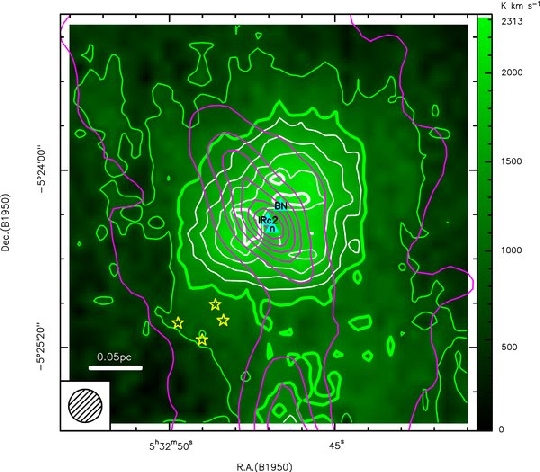
 CSO
obtained a new high-fidelity map of CO 7-6 emission of the Orion
massive star forming region.
CSO
obtained a new high-fidelity map of CO 7-6 emission of the Orion
massive star forming region. 
Astronomers used the
10.4 m Leighton telescope at the Caltech Submillimeter Observatory
(CSO) with an 800 GHz band heterodyne receiver to study the heart of
the Orion nebula
where a cluster of massive stars is being born, and have successfully
taken high fidelity image
of the region using carbon monoxide (CO) J=7-6 emission at 372 micron
(807 GHz).
The CO molecular emission traces warm dense gas in the interstellar
space. Figure 1 shows
the map of CO molecular gas in the region. The map was obtained
using a technique called
"On-the-fly" mapping method. The technique allows astronomers to
make a map of the emission
with high fidelity. Astronomers utilized the new data to diagnose
motion
of high density gas to
investigate the medium that is currently accreting onto a central
massive
protostar. From the
data set, the mass of the protostar is estimated to be about 20
times the Sun's
mass. The new
high fidelity map of warm dense molecular gas brought crucial
observational constraints on
theories to investigate how such massive stars are born. The
results were published in the
2009
September 20 issue of The Astrophysical Journal (Furuya and
Shinnaga 2009).

Figure
1. CO J=7-6 emission map taken at the CSO (Green and white
contours) overlaid on
the dust continuum emission map taken at 350 micron (magenta contours:
Lis et al. 1998).
The blue triangles with source names show the positions of young
stars. The yellow
stars mark the positions of the Trapezium members. The hatched
ellipse at the
bottom left corder indicates the spatial resolution of the CO 7-6 map.
Go back to A Digest of Recent News and
Scientific Results at the Caltech Submillimeter Observatory

 CSO
obtained a new high-fidelity map of CO 7-6 emission of the Orion
massive star forming region.
CSO
obtained a new high-fidelity map of CO 7-6 emission of the Orion
massive star forming region. 

 CSO
obtained a new high-fidelity map of CO 7-6 emission of the Orion
massive star forming region.
CSO
obtained a new high-fidelity map of CO 7-6 emission of the Orion
massive star forming region. 
